#there's stories about children modelling their games after radio shows and men talking about how the songs on the radio got them through the
Explore tagged Tumblr posts
Text
i hate history why am i crying doing my readings. AGAIN.
#i'm reading about pop culture as a form of industrial folk culture and there's all these quotes from people#talking about the radio and how it became almost a part of the community#there's stories about children modelling their games after radio shows and men talking about how the songs on the radio got them through the#depression........ i'm so emotional rn this is insane
3 notes
·
View notes
Text
Philip K. Dick, For Dummies.
I’ve been researching PK.D for a few years now, as he’s my father’s favourite author and I’ve been watching movie and show adaptations of his work for the longest time. I have personally only read the books listed, here’s the order (I think) you should read them in, based on difficulty level and the knowledge you need of the PKD canon to understand the books that follow. This is purely my opinion based on knowledge of the author. by philip-k’s-dick (lol)
Beginner. (These books and stories allow readers to explore Dick’s pet themes and stylistic quirks without falling too far down the rabbit hole)
The Short Stories: Over the course of his life, PKD wrote somewhere in the range of 150 short stories. Naturally, it would be silly of me to dump all of them on you at once, but undeniably, the shorter format allows the big ideas of Dick’s work to come through more clearly, and even the screwier stories conform to relatively coherent shape, making them an excellent jumping off point, especially for an author who wrote almost nonstop throughout his life.
My Favourites:
In The Days of Perky Pat - In this novel, survivors of a global thermonuclear war live in isolated enclaves in California, surviving off what they can scrounge from the wastes and supplies delivered from Mars. The older generation spend their leisure time playing with the eponymous doll in an escapist role-playing game that recalls life before the apocalypse — a way of life that is being quickly forgotten. At the story's climax, a couple from one isolated outpost of humanity plays a game against the dwellers of another outpost (who play the game with a doll similar to Perky Pat dubbed "Connie Companion") in deadly earnest. The survivors' shared enthusiasm for the Perky Pat doll and the creation of her accessories from vital supplies is a sort of mass delusion that prevents meaningful re-building of the shattered society. In stark contrast, the children of the survivors show absolutely no interest in the delusion and have begun adapting to their new life.
(Elements of the story were later incorporated into Dick's novel The Three Stigmata of Palmer Eldritch, written in 1964 and published in 1965, in which a Perky Pat simulation game is induced by drugs and miniature models instead. Palmer Eldritch is not a continuation or sequel however.)
What the Dead Men Say - Death is followed by a period of 'half-life', a short amount of time which can be rationed out over long periods in which the dead can be revived—so that, potentially, they can 'live' on for a long time. When attempts to bring back important businessman Louis Sarapis fail, it's clearly more than mere negligence. Sure enough, Sarapis starts speaking from beyond the grave. From outer space, in fact. Yet no-one seems terribly bothered, other than those directly concerned in the plot mechanics. Eventually entire communications networks (phones, TV, radio) are blocked by Sarapis' broadcasts
(Philip's later novel Ubik is a continuation of What the Dead Men Say)
Autofac - Three men wait outside their settlement for an automated delivery truck. Five years earlier, during the Total Global Conflict, a network of hardened automatic factories ("autofacs") had been set up with cybernetic controls that determine what food and consumer goods to manufacture and deliver. Human input had been lost, and the men planned disruption to try to establish communication and take over control. They destroy the delivery, but the truck radios the autofac and unloads an identical replacement, then prevents them from reloading items. They act out being disgusted with the milk delivery and are given a complaints checklist. In a blank space, they write improvised semantic garble—"the product is thoroughly pizzled". The autofac sends a humanoid data collector that communicates on an oral basis, but is not capable of conceptual thought, and they are unable to persuade the network to shut down before it consumes all resources. Their next strategy sets neighbouring autofacs in competition with each other for rare resources and seemingly succeeds, but there is a hidden level
Beyond Lies The Wub - Peterson, a crew member of a spaceship loading up with food animals on Mars, buys an enormous pig-like creature known as a "wub" from a native just before departure. Franco, his captain, is worried about the extra weight but seems more concerned about its taste, as his ship is short of food. However, after takeoff, the crew realizes that the wub is a very intelligent creature, capable of telepathy and maybe even mind control.
Peterson and the wub spend time discussing mythological figures and the travels of Odysseus. Captain Franco, paranoid after an earlier confrontation with the Wub which left him temporarily paralyzed, bursts in and insists on killing and eating the wub. The crew becomes very much opposed to killing the sensitive creature after it makes a plea for understanding, but Franco still makes a meal out of him. At the dinner table, Captain Franco apologises for the "interruption" and resumes the earlier conversation between Peterson and the Wub - which now has apparently taken over the Captain's body
Human Is - Jill Herrick and her husband Lester are in the middle of an argument. Lester deflects his wife’s claim that he is “hideous” with cold indifference. He tells her that he will not allow their child in the house and will have him removed to government custody because he is interfering with his research. Before the distraught Jill can pass this onto their son Gus, Lester gets news that he will be taking a trip to Rexor IV. Despite Jill’s desire to go there and see the planet, Lester insists that he will go alone.
Later Jill tells her brother Frank and she is going to leave Lester. She explains how happy she has been with Lester gone and how he seems to be getting worse every year of their marriage. More cold and more “ruthless,” not to mention the incessant working.
Lester comes home a very different man. He praises Jill’s cooking and expresses disgust with his work on Rexor IV studying toxins. He says he prefers Terra and being home with his wife.
Jill reports these changes to Frank, while Lester is playing in the room with Gus. Frank has Lester brought to a lab for more studies under the guidance of the Federal Clearance agency. Before long they realize that Lester has had his body taken over by a Rexorian.
The Hanging Stranger - The protagonist, Ed Loyce, is a store owner who is disturbed when he sees a stranger hanging from a lamppost, but finds that other people consider the apparent lynching unremarkable.
He finds evidence that alien insects have taken over, manages to get out of town, talks to the police commissioner, who believes him, and after getting all the information about what Ed knows, explains that the body was hung to see if anyone reacted to it, anyone they didn't have control over. He then takes Ed outside and hangs him from a lamppost.
The Commuter - Ed Jacobson is a railway worker at Woking station. His life takes a turn for the worse when his son, Sam, begins experiencing psychotic episodes. When he is selling rail tickets at work, a young woman named Linda asks for a ticket to a destination called Macon Heights that is not listed on any map.
The Minority Report - In a future society, three mutants foresee all crime before it occurs. Plugged into a great machine, these "precogs" allow a division of the police called Precrime to arrest suspects before they can commit any actual crimes. When the head of Precrime, John Anderton, is himself predicted to murder a man whom he has never met, Anderton is convinced a great conspiracy is afoot
Full Books:
Do Androids Dream of Electric Sheep? - Rick Deckard, a bounty hunter for the San Francisco Police Department, is assigned to "retire" (kill) six androids of the new and highly intelligent Nexus-6 model which have recently escaped from Mars and traveled to Earth. These androids are made of organic matter so similar to a human's that only a posthumous "bone marrow analysis" can independently prove the difference, making them almost impossible to distinguish from real people. Deckard hopes this mission will earn him enough bounty money to buy a live animal to replace his lone electric sheep to comfort his depressed wife Iran. Deckard visits the Rosen Association's headquarters in Seattle to confirm the accuracy of the latest empathy test meant to identify incognito androids. Deckard suspects the test may not be capable of distinguishing the latest Nexus-6 models from genuine human beings, and it appears to give a false positive on his host in Seattle, Rachael Rosen, meaning the police have potentially been executing human beings. The Rosen Association attempts to blackmail Deckard to get him to drop the case, but Deckard retests Rachael and determines that Rachael is, indeed, an android, which she ultimately admits.
Clans of the Alphane Moon - War between Earth and insectoid-dominated Alpha III ended over a decade ago. (According to the novel, "Alphane" refers to the nearest star to our own system, Alpha Centauri). Some years after the end of hostilities, Earth intends to secure its now independent colony in the Alphane system, Alpha III M2. As a former satellite-based global psychiatric institution for colonists on other Alphane system worlds unable to cope with the stresses of colonisation, the inhabitants of Alpha III M2 have lived peacefully for years. But, under the pretence of a medical mission, Earth intends to take their colony back.
Against this background, Chuck Rittersdorf and his wife Mary are separating. Although they think they are going their separate ways, they soon find themselves together again on Alpha III M2. Mary travels there through government work, Chuck sees it as a chance to kill Mary using his remote control simulacrum. Along the way he is guided by his Ganymedean slime mould neighbour Lord Running Clam and Mary finds herself manipulated by the Alphane sympathiser, comedian Bunny Hentman.
The Man in the High Castle - In 1962, 15 years after Imperial Japan and Nazi Germany have won World War II, Robert "Bob" Childan owns an Americana antique shop in San Francisco, California (located in the Japanese-occupied Pacific States of America), which is most commonly frequented by the Japanese, who make a fetish of romanticized American cultural artifacts. Childan is contacted by Nobusuke Tagomi, a high-ranking Japanese trade official, who is seeking a gift to impress a visiting Swedish industrialist named Baynes. Childan's store is stocked in part with counterfeit antiques from the Wyndam-Matson Corporation, a metalworking company. Frank Frink (formerly Fink), a secretly Jewish-American veteran of World War II, has just been fired from the Wyndam-Matson factory, when he agrees to join a former co-worker to begin a handcrafted jewellery business. Meanwhile, Frink's ex-wife, Juliana, works as a judo instructor in Canon City, Colorado (in the neutral buffer zone of Mountain States), where she begins a sexual relationship with an Italian truck driver and ex-soldier, Joe Cinnadella. Throughout the book, many of these characters frequently make important decisions using prophetic messages they interpret from the I Ching, a Chinese cultural import. Many characters are also reading a widely banned yet extremely popular new novel, The Grasshopper Lies Heavy, which depicts an alternate history in which the Allies won World War II in 1945, a concept that amazes and intrigues its readers.
Frink reveals that the Wyndam-Matson Corporation has been supplying Childan with counterfeit antiques, which works to blackmail Wyndam-Matson for money to finance Frink's new jewelry venture. Tagomi and Baynes meet, but Baynes repeatedly delays any real business as they await an expected third party from Japan. Suddenly, the public receives news of the death of the Chancellor of Germany, Martin Bormann, after a short illness. Childan tentatively, on consignment, takes some of Frink's "authentic" new metalwork and attempts to curry favour with a Japanese client, who surprisingly considers Frink's jewelry immensely spiritually alive. Juliana and Joe take a road trip to Denver, Colorado and Joe impulsively decides they should go on a side-trip to meet the mysterious Hawthorne Abendsen, author of The Grasshopper Lies Heavy, who supposedly lives in a guarded fortress-like estate called the "High Castle" in Cheyenne, Wyoming. Soon, Joseph Goebbels is announced as the new German Chancellor.
Intermediate. (These are the books to pick up once you have the basics of what makes a PKD novel down. They’re obtuse enough to hit a little heavier, but don’t provide the full dose of surrealism Dick was capable of serving up. This is also good spot to jump in if you’ve experienced weird fiction before.)
Flow My Tears, The Policeman Said - The novel is set in a dystopian version of 1988, following a Second Civil War which led to the collapse of the United States' democratic institutions. The National Guard ("nats") and US police force ("pols") reestablished social order through instituting a dictatorship, with a "Director" at the apex, and police marshals and generals as operational commanders in the field. Resistance to the regime is largely confined to university campuses, where radicalized former university students eke out a desperate existence in subterranean kibbutzim. Recreational drug use is widespread, and the age of consent has been lowered to twelve. The black population has almost been rendered extinct. Most commuting is undertaken by personal aircraft, allowing great distances to be covered in little time.
The novel begins with the protagonist, Jason Taverner, a singer, hosting his weekly TV show which has an audience of 30 million viewers. His special guest is his girlfriend Heather Hart, also a singer. Both Hart and Taverner are "Sixes", members of an elite class of genetically engineered humans. While leaving the studio, Taverner is telephoned by a former lover, who asks him to pay her a visit. When Taverner arrives at her apartment, the former lover attacks him by throwing a parasitic life-form at him. Although he manages to remove most of the life-form, parts of it are left inside him. After being rescued by Hart, he is taken to a medical facility.
Waking up the following day in a seedy hotel with no identification, Taverner becomes worried, as failure to produce identification at one of the numerous police checkpoints would lead to imprisonment in a forced labor camp. Through a succession of phone calls made from the hotel to colleagues and friends who now claim not to know him, Taverner establishes that he is no longer recognized by the outside world. He soon manages to bribe the hotel's clerk into taking him to Kathy Nelson, a forger of government documents. However, Kathy reveals that both she and the clerk are police informants, and that the lobby clerk has placed a microscopic tracking device on him. She promises not to turn Taverner over to the police on the condition that he spend the night with her. Although he attempts to escape, Kathy confronts him again after he has successfully passed a police checkpoint using the forged identity cards. Feeling in her debt, he accompanies Kathy to her apartment block, where Inspector McNulty, Kathy's police handler, is waiting. McNulty has located Taverner via the tracking device the hotel lobby clerk placed on him, and instructs Taverner to come with him to the 469th Precinct police station so that further biometric identity checks can be performed.
Time out of Joint - Ragle Gumm lives in the year 1959 in a quiet American suburb. His unusual profession consists of repeatedly winning the cash prize in a local newspaper contest called "Where Will The Little Green Man Be Next?". Gumm's 1959 has some differences from ours: the Tucker car is in production, AM/FM radios are scarce to non-existent, and Marilyn Monroe is a complete unknown. As the novel opens, strange things begin to happen to Gumm. A soft-drink stand disappears, replaced by a small slip of paper with the words "SOFT-DRINK STAND" printed on it in block letters. Intriguing little pieces of the real 1959 turn up: a magazine article on Marilyn Monroe, a telephone book with non-operational exchanges listed and radios hidden away in someone else's house. People with no apparent connection to Gumm, including military pilots using aircraft transceivers, refer to him by name. Few other characters notice these or experience similar anomalies; the sole exception is Gumm's supposed brother-in-law, Victor "Vic" Nielson, in whom he confides. A neighborhood woman, Mrs. Keitelbein, invites him to a civil defense class where he sees a model of a futuristic underground military factory. He has the unshakeable feeling he's been inside that building many times before.
Confusion gradually mounts for Gumm. His neighbor Bill Black knows far more about these events than he admits, and, observing this, begins worrying: "Suppose Ragle [Gumm] is becoming sane again?" In fact, Gumm does become sane, and the deception surrounding him (erected to protect and exploit him) begins to unravel
Ubik - By the year 1992, humanity has colonized the Moon and psychic powers are common. The protagonist, Joe Chip, is a debt-ridden technician working for Runciter Associates, a "prudence organization" employing "inertials"—people with the ability to negate the powers of telepaths and "precogs"—to enforce the privacy of clients. The company is run by Glen Runciter, assisted by his deceased wife Ella who is kept in a state of "half-life", a form of cryonic suspension that allows the deceased limited consciousness and ability to communicate. While consulting with Ella, Runciter discovers that her consciousness is being invaded by another half-lifer named Jory Miller
Difficult. (This section comes with a caveat: within these novels you will encounter numerous hallucinations, drug trips, an entire trilogy about gnostic spirituality and mental illness, and more than a little unabashed nightmare fuel. It’s normal to get tangled up in what goes on in these books. It’s also normal to be weirded out. But with proper grounding, you’ll make it though with your faculties intact. Probably.)
The Three Stigmata of Palmer Eldritch - The story begins in a future world where global temperatures have risen so high that in most of the world it is unsafe to be outside without special cooling gear during daylight hours. In a desperate bid to preserve humanity and ease population burdens on Earth, the UN has initiated a "draft" for colonizing the nearby planets, where conditions are so horrific and primitive that the unwilling colonists have fallen prey to a form of escapism involving the use of an illegal drug (Can-D) in concert with "layouts." Layouts are physical props intended to simulate a sort of alternative reality where life is easier than either the grim existence of the colonists in their marginal off-world colonies, or even Earth, where global warming has progressed to the point that Antarctica is prime vacation resort territory. The illegal drug Can-D allows people to "share" their experience of the "Perky Pat" (the name of the main female character in the simulated world) layouts. This "sharing" has caused a pseudo-religious cult or series of cults to grow up around the layouts and the use of the drug.
Up to the point where the novel begins, New York City-based Perky Pat (or P.P.) Layouts, Inc., has held a monopoly on this product, as well as on the illegal trade in the drug Can-D which makes the shared hallucinations possible.
The novel opens shortly after Barney Mayerson, P.P. Layouts' top precog, has received a "draft notice" from the UN for involuntary resettlement as a colonist on Mars. Mayerson is sleeping with his assistant, Roni Fugate, but remains conflicted about the divorce, which he himself initiated, from his first wife Emily, a ceramic pot artist. Meanwhile, Emily's second husband tries to sell her pot designs to P.P. Layouts as possible accessories for the Perky Pat virtual worlds—but Barney, recognizing them as Emily's, rejects them out of spite.
A Scanner Darkly - When performing his work as an undercover agent, Arctor goes by the name "Fred" and wears a "scramble suit" that conceals his identity from other officers. Then he is able to sit in a police facility and observe his housemates through "holo-scanners", audio-visual surveillance devices that are placed throughout the house. Arctor's use of the drug causes the two hemispheres of his brain to function independently or "compete". When Arctor sees himself in the videos saved by the scanners, he does not realize that it is him. Through a series of drug and psychological tests, Arctor's superiors at work discover that his addiction has made him incapable of performing his job as a narcotics agent. They do not know his identity because he wears the scramble suit, but when his police supervisor suggests to him that he might be Bob Arctor, he is confused and thinks it cannot be possible.
Donna takes Arctor to "New-Path", a rehabilitation clinic, just as Arctor begins to experience the symptoms of Substance D withdrawal. It is revealed that Donna has been a narcotics agent all along, working as part of a police operation to infiltrate New-Path and determine its funding source. Without his knowledge, Arctor has been selected to penetrate the organization. As part of the rehab program, Arctor is renamed "Bruce" and forced to participate in cruel group-dynamic games, intended to break the will of the patients
(If this one seems difficult to wrap your mind around, that's because its a fictionalized account of real events, and you may need to read about Philip's life at the time to understand the autobiographical nature of the book.)
The VALIS Trilogy
(Fictionalized account of religious experiences in PKD’s life.)
VALIS - In March, 1974, Horselover Fat (the alter-personality of Philip K. Dick) experiences visions of a pink beam of light that he calls Zebra and interprets as a theophany exposing hidden facts about the reality of our universe, and a group of others join him in researching these matters. One of their theories is that there is some kind of alien space probe in orbit around Earth, and that it is aiding them in their quest; it also aided the United States in disclosing the Watergate scandal and the resignation of Richard Nixon in August, 1974. Kevin turns his friends onto a film called Valis that contains obvious references to revelations identical to those that Horselover Fat has experienced, including what appears to be time dysfunction. The film is itself a fictional account of an alternative-universe version of Nixon ("Ferris F. Fremount") and his fall, engineered by a satellite called valis. (The plot of the fictitious film Valis was that of Dick's then-unpublished novel Radio Free Albemuth.) In seeking the film's makers, Kevin, Phil, Fat, and David—now calling themselves the Rhipidon Society—head to an estate owned by popular musician Eric Lampton and his wife Linda. They decide the goal that they have been led toward is Sophia Lampton, who is two-years old and the Messiah or incarnation of Holy Wisdom (Pistis Sophia) anticipated by some variants of Gnostic Christianity. In addition to healing Phil's schizophrenic personality split, she tells them that their conclusions about valis (which Fat had previously termed "Zebra") and reality are correct, and more importantly, that we should worship, not gods, but humanity. She dies two days later due to a laser accident caused by Brent Mini. Undeterred, Fat (who has now resurged) goes on a global search for the next incarnation of Sophia.
Dick also offers a rationalist explanation of his apparent theophany, acknowledging that it might have been visual and auditory hallucinations from either schizophrenia or drug addiction sequelae.
Characters:
Phil (Philip K. Dick): Narrator (first person), science fiction writer, author of Man in the High Castle, Do Androids Dream of Electric Sheep?, and Three Stigmata.
Horselover Fat: Narrator (third person), a schizophrenic modality of Phil himself. (Philip in Greek means "fond of horses"; dick is German for "fat".)
Gloria Knudson: Suicidal friend of Fat's who Fat is unable to save.
Kevin: Cynical friend of Fat's whose cat died running across the street, based on K. W. Jeter.
Sherri Solvig: Church-going friend of Fat's, eventually dies from lymphatic cancer.
David: Catholic friend of Fat's, based on Tim Powers.
Eric Lampton: Rock star, screenwriter, actor, a. k. a. "Mother Goose"; a fictionalised version of David Bowie.
Linda Lampton: Actress, wife of Eric Lampton.
Brent Mini: Electronic composer, a fictionalised version of Brian Eno.
Sophia Lampton: Two-year-old child (personalised incarnation of Holy Wisdom within some variants of Gnosticism), said to be the daughter of Linda Lampton and valis and the "Fifth Savior".
The Divine Invasion - After a fatal car accident on Earth, Herb Asher is placed into cryonic suspension as he waits for a spleen replacement. Clinically dead, Herb experiences lucid dreams while in suspended animation and relives the last six years of his life.
In the past, Herb lived as a recluse in an isolated dome on a remote planet in the binary star system, CY30-CY30B. Yah, a local divinity of the planet in exile from Earth, appears to Herb in a vision as a burning flame, and forces him to contact his sick female neighbor, Rybys Rommey, who happens to be terminally ill with multiple sclerosis and pregnant with Yah's child.
With the help of the immortal soul of Elijah, who takes the form of a wild beggar named Elias Tate, Herb agrees to become Rybys's legal husband and father of the unborn "savior". Together they plan to smuggle the six-month pregnant Rybys back to Earth, under the pretext of seeking help for Rybys' medical condition at a medical research facility. After being born in human form, Yah plans to confront the fallen angel Belial, who has ruled the Earth for 2000 years since the fall of Masada in the first century CE. Yah's powers, however, are limited by Belial's dominion on Earth, and the four of them must take extra precautions to avoid being detected by the forces of darkness.
Things do not go as planned. "Big Noodle", Earth's A.I. system, warns the ecclesiastical authorities in the Christian-Islamic church and Scientific Legate about the divine "invasion" and countermeasures are prepared. A number of failed attempts are made to destroy the unborn child, all of them thwarted by Elijah and Yah. After successfully making the interstellar journey back to Earth and narrowly avoiding a forced abortion, Rybys and Herb escape in the nick of time, only to be involved in a fatal taxi crash, probably due to the machinations of Belial. Rybys dies from her injuries sustained in the crash, and her unborn son Emmanuel (Yah in human form) suffers brain damage from the trauma but survives. Herb is critically injured and put into cryonic suspension until a spleen replacement can be found. Baby Emmanuel is placed into a synthetic womb, but Elias Tate manages to sneak Emmanuel out of the hospital before the church is able to kill him.
Six years pass. In a school for special children, Emmanuel meets Zina, a girl who also seems to have similar skills and talents, but acts as a surrogate teacher to Emmanuel. For four years, Zina helps Emmanuel regain his memory (the brain damage caused amnesia) and discover his true identity as Yah, creator of the universe.
When he's ready, Zina shows Emmanuel her own parallel universe. In this peaceful world, organized religion has little influence, Rybys Rommey is still alive and married to Herb Asher, and Belial is only a goat kid living in a petting zoo.
In an act of kindness, Zina and Emmanuel liberate the goat-creature from his cage, momentarily forgetting that the animal is Belial. The goat-creature finds Herb Asher and attempts to retain control of the world by possessing him and convincing him that Yahweh's creation is an ugly thing that should be shown for what it really is. Eventually Herb is saved by Linda Fox, a young singer whom he loves and who is his own personal Savior; she and the goat-creature meet and she kills it, defeating Belial. He finally discovers that this meeting happens over again for everyone in the world, and whether they choose Belial or their Savior decides if they find salvation.
Characters:
Herb Asher: audio engineer
Rybys Rommey: mother of Emmanuel, sick with MS
Yah: Yahweh
Elias Tate: Incarnation of Elijah
Emmanuel (Manny): Yah incarnated in human form
Zina Pallas: Shekhinah
Linda Fox: singer, songwriter, Yetzer Hatov
Belial: Yetzer Hara
Fulton Statler Harms: Chief prelate of the Christian-Islamic Church (C.I.C), Cardinal of the Roman Catholic Church
Nicholas Bulkowsky: Communist Party Chairman, Procurator maximus of the Scientific Legate
VALIS: agent of Yahweh, disinhibiting stimulus
The Transmigration of Timothy Archer - Set in the late 1960s and 1970s, the story describes the efforts of Episcopal Bishop Timothy Archer, who must cope with the theological and philosophical implications of the newly discovered Gnostic Zadokite scroll fragments. The character of Bishop Archer is loosely based on the controversial, iconoclastic Episcopal Bishop James Pike, who in 1969 died of exposure while exploring the Judean Desert near the Dead Sea in the West Bank.
As the novel opens, it is 1980. On the day that John Lennon is shot and killed, Angel Archer visits the houseboat of Edgar Barefoot, (a guru based on Alan Watts), and reflects on the lives of her deceased relatives. During the sixties, she was married to Jeff Archer, son of the Episcopal Bishop of California Timothy Archer. She introduced Kirsten Lundborg, a friend, to her father-in law, and the two began an affair. Kirsten has a son, Bill, from a previous relationship, who has schizophrenia, although he is knowledgeable as an automobile mechanic. Tim is already being investigated for his allegedly heretical views about the Holy Ghost.
Jeff commits suicide due to his romantic obsession with Kirsten. However, after poltergeist activity, he manifests to Tim and Kirsten at a seance, also attended by Angel. Angel is skeptical about the efficacy of astrology, and believes that the unfolding existential situation of Tim and Kirsten is akin to Friedrich Schiller's German Romanticism era masterpiece, the Wallenstein trilogy (insofar as their credulity reflects the loss of rational belief in contemporary consensual reality).
The three are told that Kirsten and Tim will die. As predicted, Kirsten loses her remission from cancer, and also commits suicide after a barbiturate overdose. Tim travels to Israel to investigate whether or not a psychotropic mushroom was associated with the resurrection, but his car stalls, he becomes disoriented, falls from a cliff, and dies in the desert.
On the houseboat, Angel is reunited with Bill, Kirsten's son who has schizophrenia. He claims to have Tim's reincarnated spirit within him, but is soon institutionalized. Angel agrees to care for Bill, in return for a rare record (Koto Music by Kimio Eto) that Edgar offers her.
The Transmigration of Timothy Archer is one of Dick's most overtly philosophical and intellectual works. While Dick's novels usually employ multiple narrators or an omniscient perspective, this story is told in the first person by a single narrator: Angel Archer, Bishop Archer's daughter-in-law.
Characters:
Angel Archer: Narrator, manager of a Berkeley record store, widow of Jeff Archer.
Timothy Archer: Bishop of California; father of the late Jeff Archer and father-in-law of Angel. Dies in Israel, searching for psychotropic mushroom connected with Zadokite sect. Based on James Albert Pike, Dick's personal friend, who was an American Episcopalian bishop.
Kirsten Lundborg: Timothy Archer's secretary and lover. Dies from barbiturate overdose after loss of remission from cancer.
Bill Lundborg: Kirsten's son who has schizophrenia, and who is obsessed with cars.
Edgar Barefoot: Houseboat guru, radio personality, lecturer. Based on Alan Watts.
Jeff Archer: Son of Timothy Archer, and deceased husband of Angel. A professional student who was romantically obsessed with Kirsten.
Thank you, if you read all of this. it took me six hours today to write this all
#scifi#science fiction#philip k dick#electric dreams#blade runner#in the days of perky pat#what the dead men say#autofac#beyond lies the wub#human is#the hanging stranger#the commuter#minority report#do androids dream of electric sheep#clans of the alphane moon#the man in the high castle#flow my tears the policemen said#time out of joint#ubik#the three stigmata of palmer eldritch#a scanner darkly#valis#the valis trilogy
66 notes
·
View notes
Text
THREE LITTLE PIGSKINS
December 8, 1934
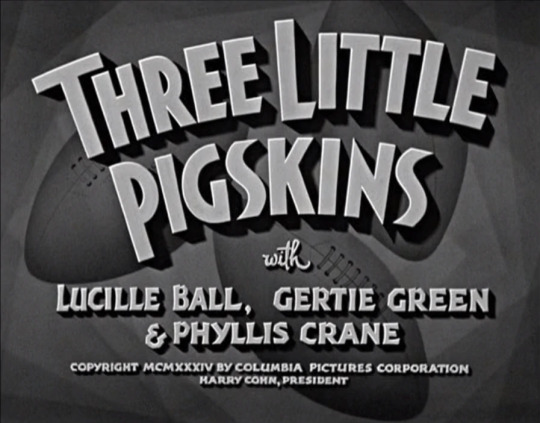
Three Little Pigskins is a 1934 Columbia Pictures short subject directed by Raymond McCarey and starring slapstick comedy team The Three Stooges. It is the fourth entry in the series starring the comedians, who released 190 short films for the studio between 1934 and 1959.
Synopsis ~ Moe, Larry and Curly are hired to promote a university football team. They're soon mistaken for the school's famous star athletes, "The Three Horsemen." As the star athletes, they are hired by a gangster to secretly play on his professional team, but of course the boys know nothing about football.

PRINCIPAL CAST

The Three Stooges were an American vaudeville and comedy team active from 1922 until 1970. Their hallmark was physical farce and slapstick. Six Stooges appeared over the act's run with only three active at any given time. In this film they are:
Moe Howard (Moe) born Moses Horwitz in 1897. Died 1975.
Larry Fine (Larry) born Larry Feinberg in 1902. Died 1975.
Curly Howard (Curly) born Jerome Horwitz in 1903, Moe’s younger brother. Died in 1952.
This short film is the only time the three worked with Lucille Ball.

Lucille Ball (Daisy Simms). This is Ball’s 17th film to be released since 1933. It is her 13th in 1934 alone.
Gertie Green (Lulu Banks) makes the third of her four screen appearances.
Phyllis Crane (Molly Gray) was also seen with Lucille Ball in Broadway Bill and Men of the Night, both in 1934.
UNCREDITED CAST (in alphabetical order)
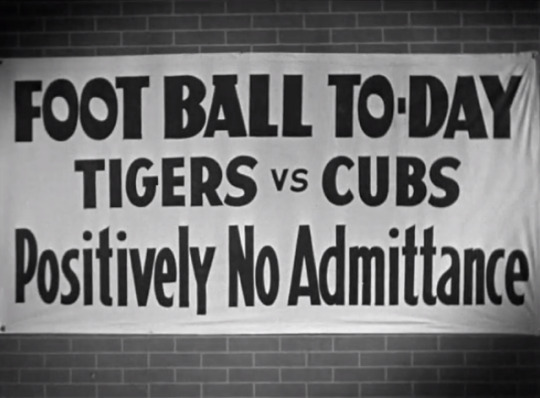
Harry Bowen (Boulder Dam PR Man) also appeared with Lucille Ball in The Whole Town’s Talking (1935) and Dummy Ache (1936).
Lynton Brent (1st Man Panhandled by Moe) appeared with Lucille Ball in seven other films between 1934 and 1939.
Bobby Burns (Man Panhandled by Larry) also appeared with Lucille Ball and Harry Bowen in Dummy Ache (1936).
Charles Dorety (2nd Photographer) also appeared with Lucille Ball in His Old Flame (1935).
Milton Douglas (Henchman) makes his only appearance with Lucille Ball.
Oscar ‘Dutch’ Hendrian (Referee) did five other films with Lucille Ball between 1934 and 1935.
William J. Irving (1st Photographer) did five other films with Lucille Ball between 1933 and 1935.
Johnny Kascier (Man Panhandled by Curly) makes his only appearance with Lucille Ball.
Walter Long (Joe Stacks) also appeared with Lucille Ball in The Whole Town’s Talking (1935).
Roger Moore (Pete, Joe’s Henchman) also appeared with Lucille Ball in Meet the People (1944) and The Fuller Brush Girl (1950).
The role of Joe is sometimes attributed to Joseph Young.
Jimmy Phillips (2nd Man Panhandled by Moe) also appeared with Lucille Ball in The Whole Town’s Talking (1935)
Larry Wheat (3rd Man Panhandled by Moe) appeared with Lucille Ball in Thousands Cheer (1943).
PIGSKIN TRIVIA

Three Little Pigskins was filmed from October 25 to 30, 1934 in and around Los Angeles.

The film's title is a multiple pun, derived from the children’s nursery rhyme the Three Little Pigs, along with ‘pigskin’ being a synonym for a football.
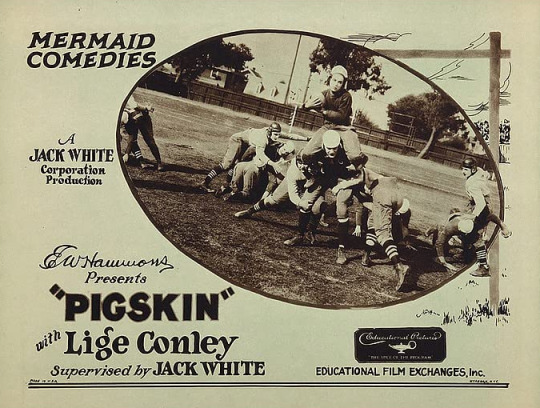
In 1924, Mermaid Comedies produced Pigskin, starring silent comedy short starring Lige Conley.
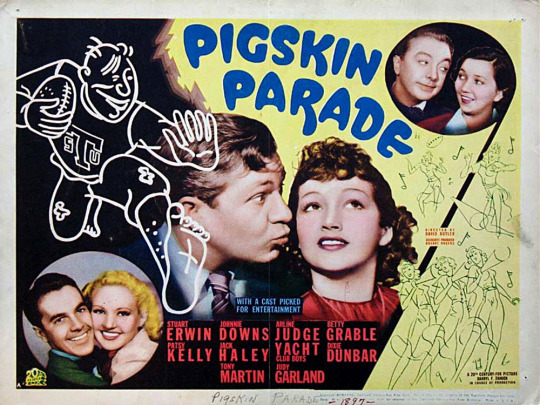
In 1936 a film titled Pigskin Parade premiered earning its leading man an Oscar nomination.

The second half of the film was shot at Gilmore Stadium, and its name on the scoreboard appears in several shots. The Los Angeles stadium was newly built in 1934 and had a seating capacity of 18,000. The football team the Stooges play against was from Loyola Marymount University, a regular tenant of Gilmore Stadium.
The Cubs on the scoreboard refers to the Westwood Cubs, who had played at the stadium on the October 28, 1934. The Tigers refers to the Occidental Tigers, a college team from Los Angeles. Neither team appears in the film.

Coincidentally, the stadium was demolished in 1952 to make way for CBS Television City, a production facility that was opened by Lucille Ball as the network’s reigning star, although “I Love Lucy” never filmed there. One of their major tenants was the Hollywood Stars Baseball team, which Fred Mertz mentions during “In Palm Springs” (ILL S4;E26) in March 1955.
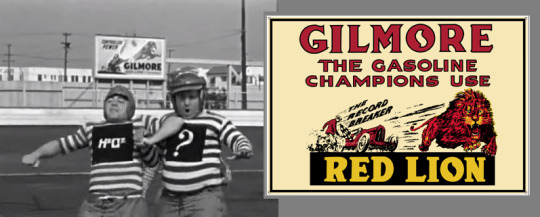
There is also a shot that includes a billboard for Gilmore Oil, including its trademark symbol, a red lion. The Gilmore Oil Company was an independent oil company in California founded by Arthur Fremont Gilmore, whom the stadium was named for. At its peak, they operated over three thousand gas stations on the West Coast. In the 1940s, the company was acquired and then merged into a group which eventually became Mobil.

The address 6317 Yucca Street on the poster behind Curly and Moe was the actual location of filming. Coincidentally, it is about a quarter mile from the Stooges’ Star on the Hollywood Walk of Fame. the location is now the Los Angeles campus of The American Musical and Dramatic Academy (AMDA).

Boulder Dam College is a fictional school. Boulder Dam is located in Clark County, Nevada and was under construction at the time of filming. It named Boulder Dam in 1933 and dedicated in 1935 and opened in 1936. It was renamed Hoover Dam in 1946.

Beyond the stadium can be glimpsed the Fairfax Theatre sign. The Fairfax Theatre opened in 1930 as part of a larger retail complex. The theatre was ‘triplexed’ in the 1980s but closed for good in 2010 after roof damage from heavy rains. The owner was unwilling to make repairs although the façade still remains.

Later in her career, Lucille Ball (apparently referring to the seltzer squirting scene) would remark,
"The only thing I learned from The Three Stooges was how to duck. I still got wet!"
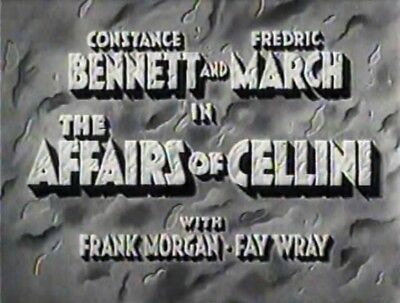
While Lucille Ball was filming Three Little Pigskins, The Affairs of Cellini, in which she played an uncredited lady in waiting, was in wide release, having premiered in late August 1934.

Moe Howard once called Three Little Pigskins "a humdinger of bangs and bruises," as it marked the first time the Stooges flatly refused to perform a stunt. In the film, during the game the boys are stopped by photographers to pose for a picture, when the football players then tackle them. The team consisted of genuine college football players, and the Stooges were afraid of being hurt. Larry Fine, the smallest and lightest of the three, told director Raymond McCarey, “We've never used stunt doubles before but we certainly need them now."

The fact that both Curly and Larry had been hurt a few days earlier (Curly broke his leg riding down the dumbwaiter and Larry lost a tooth due to a mistimed punch) reinforced the trio's decision to opt out of the scene. Less than an hour after the exchange, the studio found three stunt doubles made up to look like the Stooges. Two of the three were seriously injured as were all four photographers.
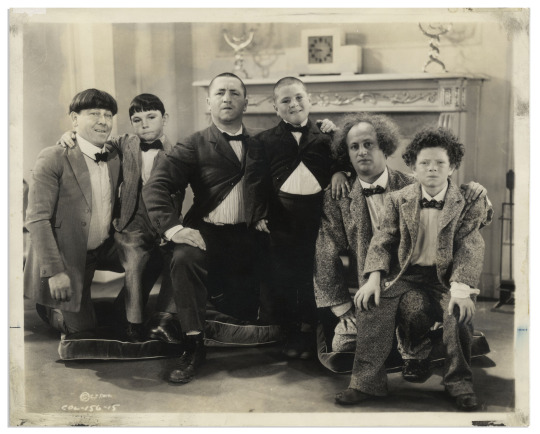
A planned concluding scene had the Stooges, years later, telling the story to their sons. It is unknown if this scene was ever filmed, but publicity photos exist of the Stooges, each with a young actor, all made up and dressed to resemble their older counterparts.

In 1996, Exclusive Premiere created limited edition action figures of the Stooges in costumes from the film.
PIGSKIN PROGRESS
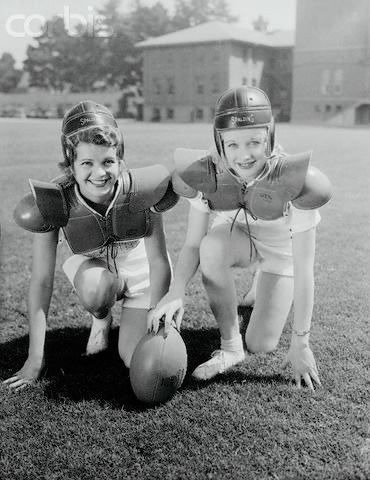
As a young model and actress, Lucille Ball didn’t just take film jobs. Here she poses with Billie Seward at Bovard Field in Los Angeles.
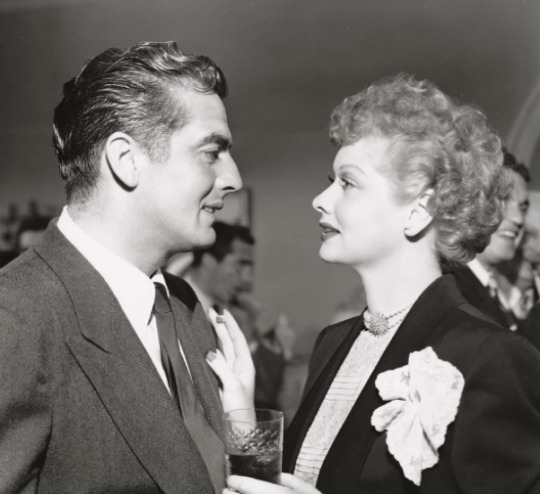
In 1949, Lucille Ball and Victor Mature starred in a film about a professional football player, Easy Living.

Ball’s radio show “My Favorite Husband” tackled gridiron gimmickry in 1950.
For a further look at Lucy and the Gridiron, click here!
23 notes
·
View notes
Text
Top 12 Female MCU Characters
In celebration for Avengers Endgame coming out I wanted to do a post that was fun and non spoilery to put my love out there for Marvel. Since I am all about women power and things I thought this would be a great thing to do!
I am only doing women in the MCU (Marvel Cinematic Universe) and this does not include TV shows that might slightly tie in to them. That was really hard. This is my opinion and not everyone will agree with it and there certainly can be a discussion but no bashing anyone of opinions. That is totally not nice. Anyway..like i said there will be no spoilers for Avengers: Endgame, but all other movies prior is free game--Be Warned!
12. Nebula
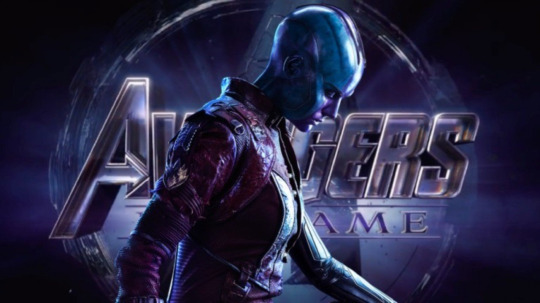
Abilities
Superhuman strength, agility and durability
Regenerative healing factor
Skilled hand-to-hand combatant
Skilled assassin
Wrist blasters
I love Nebula. Who doesn’t love an underdog story, plus she is probably one of the characters that most people could relate to. Who can’t relate to someone who has sibling rivalry? Of course, most people don’t have an insane father that will pit his children against each other into battles of almost death and when one looses the loosing child will get tortured with mutilation when getting cybernetic enhancements. The thing that most amazes me about Nebula in the MCU is her character growth. She shows that she truly loved and cared for her sister and it was the tyrant between them that kept them apart for so long. Ultimately she realizes that she was following a maniac and she starts helping the good guys in Avengers: Infinity War. I can not wait to see where her journey goes from here!

11. Hope “Wasp” van Dyne
Abilities
Size manipulation
Flight
Bio-electric energy blasts and extendable claws on her gloves
Skilled hand-to-hand combatant

Hope is the definition of independent woman in my eyes. She is a fighter. She is intelligent, not afraid to run with the big boys, teaches men how to punch, ambitious, and makes being the Wasp her own. Despite being estranged from her father for most of her childhood she learns forgiveness and softens to him when she finds out the truth about her mother. It takes a lot of character to forgive someone in my opinion and being lied to most of her life would be a lot to forgive, but in the long run letting love be the ultimate thing to win in her relationship with her dad and with Scott instead of pushing away is true bravery and a bad ass woman.
10. Agent Peggy Carter
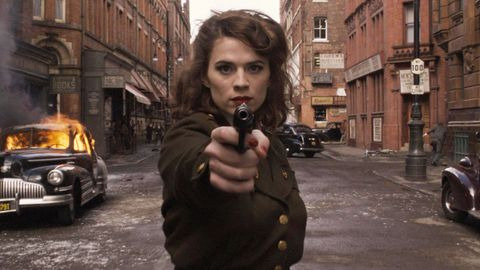
Abilities
Skilled hand-to-hand combatant
Trained in Fire Arms
Military Combatant
Skilled Agent
Peggy Carter, the one that falls in love and gets the heart of Captain America. (Lucky....) Seriously, she is definitely a woman that can be a role model for little girls. She is like the ultimate bad ass. Smart, knows how to take care of herself, refuses to be a damsel in distress type, tough as nails, but still keeps her own form of feminine charm. Like I said bad ass and great role model. I would love to learn to kick butt from this woman and I would gladly tell everyone she was the Agent I learned from.

^ Brilliant
9. Okoye

Abilities
Skilled in many forms of combat
Exceptional in using various Wakandan weaponry and tools
Brilliant Tactician and Military Strategist
When I watched Black Panther I was moved and amazed by the female empowerment in the movie. You can actually see my previous blog about it! I am still in love with that factor of the movie. Okoye is one of my all time favorite characters of the MCU and favorite parts of Black Panther because she is smiply awesome. The King of Wakanda has women...women back him up. I want all sexist pigs out there to soak that in for a moment. If you are still grumbling and thing that T’Challa was wrong, remember all this:
youtube
8. Shuri
Abilities
Animorphism
Genius-level intellect
Expert martial artist
Necromancy
Super speed
Stone skin
Use of high-tech equipment and weapons including vibranium uniform
Enhanced agility, durability, endurance, reflexes, senses, speed, stamina and strength
I love this girl, because in the MCU she is one brainy badass. In the abilities listed above we definitely see the genius level intellect and her high tech weapon use.
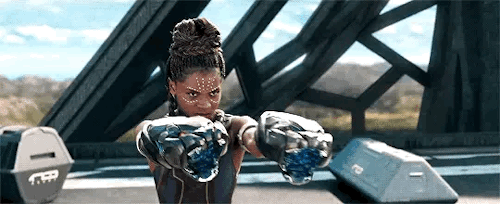
I am going to just say right now I will loose my ever loving mind if i see her animorphism and necromancy skills in the next Black Panather movies. Holy crap. Mage and Harry Potter crap there! LOL Anyway, Shuri is definitely a refreshing woman to see in movies today. A woman that can take care of herself and lets say save the man in distress.
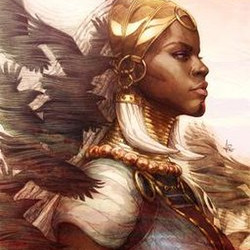
7. Mantis
Abilities
Master martial artist
Empathy
Plant manipulation
Accelerated healing factor
Astral projection
Ability to communicate telepathically with the Cotati
Energy projection
Okay, so in my opinion Mantis is one of the coolest Marvel heroines’ that has ever been introduced. I will be the first to say that she was actually one that I was not to familiar with until I looked her up after the Guardians of the Galaxy Vol. 2 came out. Honestly, I do not think they have touched on half of what Mantis can do. Master martial artist? Where was that? Plant Manipulation? Um, yes please enhance Mantis characterization in the next films please Marvel because empaths can be totally badass and she is apparently no different. In Infinity War she jumped on Thano’s back and practically immobilized him! She was that powerful! Her power made it to where she almost made Team Iron Strange (lol like what I did there with the Team that was on that planet?) successful in Infinity War. Almost...*sigh*
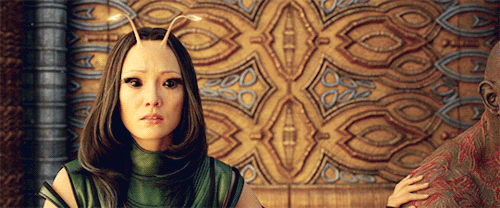
6. Pepper Potts

This entry will be a little different. I said I was not going to spoil Endgame and I plan on keeping it that way. I will probably not have any blogs stating anything specific about the movie plot and things for a little while longer. That being said I still wanted to include Pepper because even though there is things I don’t want to say about her character and her story line in Endgame I still want to say how much I love her. She is smart and a very capable women. She is the one running Stark Industries after all and the woman that is in love with Tony Stark which is also hard, but I think she is the proof that Tony has a heart throughout the entire MCU.
5. Black Widow

Abilities
Expert tactician, hand-to-hand combatant and secret agent
Slowed aging, and enhanced immune system
Expert marksman and mastery of various other weapons via gauntlets
grappling hook
knock out gas
taser
explosives
tear gas pellets
radio transmitter
If you would ask me which female superhero I would want to be like the most, I would probably tell you the super femme fetal Black Widow. Who wouldn’t want to be a beautiful super spy badass? Natasha Romanov does not need super powers to be amazing. She just is and that is part of what makes her great. She is also not afraid to say that she has demons in her past and she is definitely wanting to atone for things that she has done wrong. That takes courage and guts to want to strive to be a better person. Not many people would even try to atone for anything. Natasha...you are definitely my hero.

4. Gamora
Abilities
Superhuman strength, speed, agility, and durability
Skilled assassin
Skilled hand-to-hand combatant
The Most Dangerous Woman in the Universe

I love Gamora. I think she is fierce, smart, strong, independent, beautiful and everything a badass woman should be! She fought for what she thought was right despite going against her father’s wishes. It can be extremely hard to go against family. Let’s pretend for a moment that her father was not a total psychopathic tyrant for a moment and consider that that is a hard thing to do. Yeah, if we go back to the fact that he is a psycho and he techinically murdered half her people, including her real family, and basically kidnapped her, it would still be weird to go against the man who raised you. It would at least takes guts to go against the person that raised you into the total badass bitch machine that you are now, knowing that he is a psycho so you could become a Guardian of the Galaxy because you have better morals and values! Gamora is legend. She is the Most Dangerous Woman in the Universe!

3. Valkyrie

Abilities
Superhuman strength, speed, durability, and longevity
Mediumship with spirits of the dead
Valkyrie is one of the most complicated female characters in the MCU so far and given a lot of depth in my opinion. She suffers from PTSD, which I can relate to, because of her battle against Hela. There are not many characters that you see with Post-Traumatic-Stress-disorder. Being the only survivor of the Valkyrior because of the battle against the Goddess of Death, she suffers a lot of loss, and she was also saved by one of her sisters in arms when almost speared through the heart by Hela. She drowns her sorrows in alcohol which is actually a very human thing to see despite the fact that we are supposed to be watching a woman that is superhuman. .The reason why I really like Valkyrie so much is because how much I relate to her. Instead of drowning in sorrow she realizes that she can not run from her past but get stronger from it. She is a inspirational woman that kicks total butt!

2. Scarlet Witch
Abilities
Reality warping
Magic
Probability manipulation
Teleportation
Matter manipulation
Time manipulation
Energy projection, manipulation and absorption
First of all, I think magic in the MCU world is fascinating, needless to say I am a fantasy nerd and mages, witches, and magic is a true love of mine anyway, but Scarlet Witch is right up there with Dr. Strange. When talking about pure power and abilities she is extremely the bomb. I wont go super nerdy on everyone here because most of the reason why I love her is because of playing her in old video games like X-Men Legends (turning bad guys into boxes--hahaha boxes) and the comic story lines (House of M anyone?). If I think about her character in the MCU alone I still love her because her powers are still ultimately powerful due to the mind stone. Her powers are more telekinetic and telepathic in nature in the MCU because of this. Remember when she manipulated the Hulk? Yeah that is power! She has had to go through a lot of crap and she always uses it to make her stronger. This is what makes her awesome.

1. Captain Marvel

Abilities
Superhuman strength, speed, endurance, and stamina
Energy projection and absorption
Flight
I really struggled with how I was going to rate my last five. I was not sure whether I was going to make our dear Captain Marvel number one, but she is number one to me, because I related to her. Simple and probably selfish, but it’s my list so LOL, This is my opinion of course, but I really did pick this a lot based on how I relate to Carol Danvers. She is one powerful woman and it was a lot of manipulation that toned down that power until she realized she could utilize her emotions to make her stronger. Her character growth was essentially understanding who she was and letting herself not be afraid of her power and her emotions. Danvers is powerful, sassy, funny, a fighter pilot, and an adventurer! Who wouldn’t want to be her?

So this is my list..like I said its all my opinion and I put a lot of what I feel in the reason. If you agree or not that is cool. I love to hear people’s opinions, that is if anyone is reading this LOL, but no battering people for their opinions! No spoilers for Endgame!
Just saying also...can we please get She-Hulk in the MCU! SHEESH!
At some point I might do a top list of males in the MCU with Spiderman coming out in awhile. Maybe a list of what I love about Spiderman..cause I love Spiderman. Who knows haha
#marvel mcu#female marvel mcu list#top 12 list#top female characters#nerdy approved#female warrior#marvel superheroes#marvel superhero females
1 note
·
View note
Text
Sensor Sweep: Howard Days, Derleth Christmas Card, Tolkien Society Seminar
Robert E. Howard (Orthosphere): Considering that he died at thirty, Howard’s literary accomplishments can only impress. Stylistically, he operates at a level many ranks above that of the typical pulp writer. His vocabulary includes a rich lode of Latin and Greek derivations and likewise of English archaisms. Brought up, from age thirteen, in the small and isolated Texas town of Cross Plains, in Callahan County, in the middle of the state, Howard almost miraculously overcame a lack of educational resources and acquired a reserve of knowledge in history, literature, myth, and folklore that would shame the modern holder of a college degree in any of those subjects.
Science Fiction (Wasteland & Sky): Ever since the Pulp Revolution started, the main kickback has always been from the older set who think it exists to erase their past when it exists for the exact opposite. The whole reason the movement sprung up was because of those who began looking into the past and were finally discovering what Fandom was actually doing was rewriting and destroying what came before. They were doing it for their own gain, chasing out anyone who wanted what they had mere years earlier.
Gaming (Monster Hunter Nation): I talked about this in the last blog post about the Yard Moose Mountain Mega Shooting Weekend, where I had shooters from all over the country coming to my place for three days of pistol training, about how one night I ran a one off RPG session for 17 of them, and by some miracle it actually turned out good. When this got posted about on Facebook right after, a whole bunch of gamers asked how the hell do you run a game that big and not have it suck, so here’s how we pulled it off.
Tolkien (Breitbart): “The Tolkien Society has announced that the theme of its 2021 Summer Seminar, held July 3 – 4, will be ‘Tolkien and Diversity,’” reports the Daily Wire. Here’s a sampling of what Woketard Tolkien Fanboys can expect — you know, those whose lives are so empty, this is how they choose to spend a weekend: Gondor in Transition: A Brief Introduction to Transgender Realities in The Lord of the Rings. Pardoning Saruman?: The Queer in Tolkien’s The Lord of the Rings. The Lossoth: Indigeneity, Identity, and Antiracism.
Robert E. Howard (Adventures Fantastic): This past weekend was the 2021 Robert E. Howard Days. After last year’s cancellation, it was a much needed gathering. And while many of the regulars weren’t able to attend, the number of first time attendees made up the difference. The gift shop sold out of almost all the books they had in stock.
Awards (DMR Books): John Bullard is a good guy doing Crom’s work over at the Robert E. Howard Foundation (REHF). The other day, John sent me the list of REHF award recipients for 2020 and 2021, which were announced at Howard Days in Cross Plains a week ago. I should note that Corona-chan canceled last year’s Howard Days, so the 2020 awards were handed out this year. Check ’em out below. I’ll post my comments below that.
Fantasy (Goodman Games): Linwood Vrooman Carter was born on June 9th, 1930 in St. Petersburg, Florida. In the august company of his fellow Appendix N authors, Lin Carter is a figure both of high esteem and some controversy. As an editor and critic, he is indispensable, most notably for his role in editing the landmark Ballantine Adult Fantasy series (BAFS), which ran from 1969-1974 and re-introduced such luminaries as Lord Dunsany, William Hope Hodgson, and Clark Ashton Smith to the fantasy-reading public.
Pulp (Pulpfest): Today we celebrate the 125th birthday of TIME magazine’s “dean of science fiction writers,” William Fitzgerald Jenkins — a.k.a. Murray Leinster. An avid inventor who also happened to have a knack for writing wonderful speculative science fiction, his career spanned much of the 20th century.
Fiction (Realms of Night): In the early 1980s, Zebra Books published a four “issue” anthology series bearing the title Weird Tales and the stylized logo familiar to fans of the pulp greats who were published in The Unique Magazine. Weird Tales has been called the magazine that never dies, but most would agree it’s had a largely beleaguered existence since the late 1950s. It has appeared at various times in a newsstand digest format, a full-size traditional magazine format, and — perhaps the most successful post-Golden Era run of the magazine — a very nice perfect bound magazine during the 1980s and early 1990s.
Comic Books (National Review): How can you not know who Neal Adams is? He gave the world the modern Batman and Joker! Revived Green Arrow and the X-Men! Created the first Black superhero for DC, the John Stewart Green Lantern!
Robert E. Howard (Dark Worlds Quarterly): “The Fire of Asshurbanipal” (Weird Tales, December 1936) by Robert E. Howard is the point at which adventure fiction and horror meet. The story was found in a trunk with a note to be sent to Farnsworth Wright in case of the author’s death. This is according to Glenn Lord who published the first version of the story in The Howard Collector #16 (Spring 1972). Lord gives us a little preamble with:
RPG (Modiphius): We’re delighted to announce that Conan The Adventurer arrives in print! This latest sourcebook for the Conan Adventures in an Age Undreamed Of RPG is available now on Modiphius.net and coming soon to a retailer near you. Here are the details on this fascinating new sourcebook which is also available in PDF format on Modiphius.net and DriveThruRPG.com.
Comic Books (Arche-arc): Upon completing my viewing of the FALCON AND WINTER SOLDIER streaming series, I’m moved to comment on some of the parallels between Kevin Feige, founder of the Marvel Cinematic Universe, and Stan Lee, the founder of Marvel Comics in its crucial sixties incarnation.
Comic Books (Irmonline): I have gone into the first series run of What If? by Marvel from 1977 to 1984, with 47 issues. The title series continues to find numerous use over the years with Marvel. There is a second series that starts in 1989 and ends in 1998, with 115 issues including a #0. After that, Marvel releases a few mini-series, or one-shot stories, that go under the title What If?.
Fiction (DMR Books): I like Vikings, specifically Viking fiction. I certainly have an interest in the history, and the sagas make for dense but fascinating reading, but my first love is pure, heart-pounding adventure. I remember first learning about Vikings back in grade school, when we briefly covered the Viking explorations of the New World, the discovery of Greenland, Vinland and Viking settlements on the Canadian east coast long before that Italian explorer came along and spoiled everything.
Gaming (Game Rant): Skyrim is packed full of references to the works of H.P. Lovecraft. Its last DLC, Dragonborn, saw the inhabitants of the isolated town of Raven Rock fall under a mysterious trance-like state that was leading them to build strange obelisks, with only the faintest memory of doing so. While some The Elder Scrolls quests are full of surface-level Lovecraft allusions like this, the series’ metaphysical lore makes the connection explicit. The same can be said for Obsidian’s upcoming first-person fantasy RPG, Avowed.
Cinema (Talking Pulp): Beyond the Black Rainbow. I really dug Panos Cosmatos’ Mandy, a film that sort of came out of nowhere a few years ago that in some ways, boosted and reignited Nicolas Cage’s acting career. I don’t think that it was long-lasting but his role in Mandy proved that the dude can still bring it and excel when given the right part in a movie. Cosmatos only has one other film and, at this point, it’s already over a decade old. It’s been in my queue since I saw Mandy, however, so I felt like checking it out was long overdue.
Star Wars (Tor): The Star Wars movies are notable for spinning off into a wide variety of other media and related products, including TV shows, books, comic strips, comic books, radio dramas, toys, housewares, and other products. Since the series was largely modeled on the old Flash Gordon and Buck Rogers serials, this is no surprise, as both of those properties were also adapted into a variety of formats and merchandise, something George Lucas certainly noticed and emulated. Today, I’m going to look at two of the first Star Wars tie-in books, Splinter of the Mind’s Eye and Han Solo at Stars’ End.
Pulp (Fantasy Literature): The Universe Wreckers initially appeared as a three-part serial in the May, June and July 1930 issues of Hugo Gernsback’s Amazing Stories magazine, the first publication to dedicate itself solely to science fiction. This legendary magazine started publishing in 1926, the same year that Hamilton’s very first story, “The Monster-God of Mamurth,” appeared in Weird Tales, when its author was 22. The Universe Wreckers would then, sadly, go OOPs (out of prints) for over 80 years, until Haffner Press resurrected it for inclusion in one of its mammoth Hamilton anthologies.
Gaming (Arkhaven Comics): Last month, IGN decided that the hill to die on this week was Palestine. They printed some article on giving aid to Palestinian Children* that I didn’t care about and didn’t read because I haven’t read anything from IGN for years and I wasn’t starting now. However, IGN Israel did read it and screamed at the corporate owners. Ziff-Davis roused itself from its dreamy lassitude and made the accurate but surprising decision that this article had nothing whatsoever to do with gaming or popculture and spiked it.
Fiction (Allied Authors): Years ago on this Allied Authors website in “A Derleth Christmas Card,” I touted an unexpected find I made in a local antique store: a series of unique Christmas cards issued by Wisconsin’s famous author — and close friend of Allied Authors — August Derleth. Unexpected, because even in his home state, Derleth’s proverbial backyard, such finds are fewer and farther between, with his fame continuing to grow.
Comic Books (AE Index): An excellent representation of EC original art in an inexpensive format. Along with full-page scans of original art, this features an introduction by Annie Gaines Ashton, exhibit introduction, and twelve short essays or personal recollections from noted EC fans. There are also four double-page enlargements of art, three successful and one blurry. The scans are mostly clear with a few soft or blurry issues.
Review (Rough Edges): There’s no sophomore jinx for the second issue of MEN’S ADVENTURE QUARTERLY. It remains one of the most impressive, beautifully designed publications available today. The theme this time around for this oversized trade paperback is Espionage. It features a lot of vividly reproduced artwork, including both covers and interior illustrations, from a variety of the Men’s Adventure Magazines published in the Fifties, Sixties, and Seventies, along with seven stories (mostly fiction, even the supposedly true ones) from those magazines.
Cinema (Neotextcorp): When Rhodesian writer Daniel Carney’s unpublished novel The Thin White Line ended up in the hands of producer Euan Lloyd, it fit perfectly with his ambitious plans to make a grand-scale star-studded war adventure film in the vein of Where Eagles Dare. The novel toyed with the rumor about a mysterious 1968 plane landing in Rhodesia allegedly carrying a mercenary force, and when screenwriter Reginald Rose adapted it for film, director Andrew V. McLaglen was hired to bring it to life based on a decisive recommendation from the great John Ford. The cast was loaded with heavy-hitting names such as Richard Burton, Roger Moore, Richard Harris, Hardy Krüger, Stewart Granger, Jack Watson, Frank Finlay and many others.
Sensor Sweep: Howard Days, Derleth Christmas Card, Tolkien Society Seminar published first on https://sixchexus.weebly.com/
0 notes
Text
Rugby World Cup final: Siya Kolisi, South Africa's first black captain & legacy of 1995
New Post has been published on https://thebiafrastar.com/rugby-world-cup-final-siya-kolisi-south-africas-first-black-captain-legacy-of-1995/
Rugby World Cup final: Siya Kolisi, South Africa's first black captain & legacy of 1995


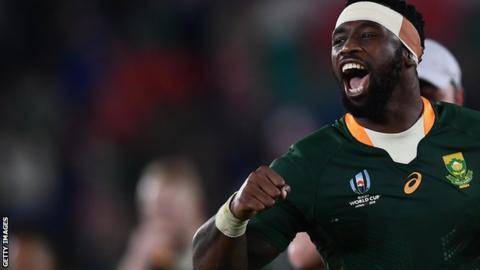
Kolisi was born one day before South Africa’s apartheid laws were officially repealed in 1991
You walk out in a Springbok jersey as a player and you feel history on your back and by your side.
You stand as South Africa’s captain in a World Cup final and the weight is greater across your shoulders and the ghosts crowd in all around.
Francois Pienaar hoisting the Webb Ellis Cup at Ellis Park in 1995, Nelson Mandela alongside him in his own green number six jersey, happy like a kid who has just scored his first try. John Smit at the Stade de France in Paris 12 years on, left hand around the old gold pot, right hand linked with Mandela’s successor Thabo Mbeki.
Twelve years more have passed. Now it is the turn of Siya Kolisi to walk that path. The first black man to captain the Springboks, a kid from nowhere who hopes to go where none have gone before.
Rugby matters in many places around the world, but only in South Africa can it change the nation around it. Captains and presidents, politics and power, new dreams and old scars.
“It was iconic when Francois lifted the World Cup with Madiba, and it was amazing to be able to do it myself with Thabo,” says Smit.
“But if Siya touches that trophy on Saturday… I tell you, it will be a far greater moment than 1995. Far greater. It would change the trajectory of our country.”
That Kolisi has made it this far is a story of stoicism and self-belief. Born to teenage parents in the poor township of Zwide, just outside Port Elizabeth on the Eastern Cape, he was brought up by his grandmother, who cleaned kitchens to make ends meet.
Bed was a pile of cushions on the living-room floor. Rugby was on dirt fields. When he went to his first provincial trials he played in boxer shorts, because he had no other kit.
His father Fezakel was a centre, his grandfather a player of pace too. Aged 12, the young Kolisi was spotted by Andrew Hayidakis, a coach at the exclusive private school Grey, and offered a full scholarship.
When you are from Zwide you step into this other world when the chance comes, but you never leave your old life behind. Kolisi’s mother died when he was 15, his grandmother shortly afterwards. When Smit’s team was beating England in that World Cup final of 2007, the 16-year-old Kolisi was watching it in a township tavern because there was no television at home.
South Africa beat England 15-6 in the 2007 World Cup in Paris
“His story is unique,” Hanyani Shimange, former Springboks prop, told BBC Radio 5 Live’s Rugby Union Weekly podcast.
“Previous generations of black rugby players were not given the same opportunities, purely because of South Africa’s laws. He’s living the dream of people who weren’t given the same opportunities as him.
“He’s grabbed those opportunities. He’s a good man, a humble individual.
“He’s got a lot of time for people, probably too much time in some instances. But he’s the same Siya he was six years ago. He loves rugby, and the team loves him.”
Kolisi began at school as a small but mobile flanker, good with the ball in hand, learning to be smarter than the stronger kids around him. When a growth spurt kicked in and he got big there was power to go with the finesse.
As a loose forward he is a significant asset to a Springbok team that at this World Cup has battled through to the final rather than dazzled. Saturday will bring his 50th cap, and his 20th as captain. His impact is far greater than simply what he does on the pitch because of all that has come before.
“I do not care how the Springboks team does. It is not a reflection of the nation. It is not our team. I support the All Blacks instead. We don’t support the national team, because it is a white South African team. It is not a true South African team.”
That was Zola Ntlokoma, secretary of Soweto Rugby Club, talking to me before England played South Africa at Twickenham five years ago. It was not an uncommon view, because for all the iconography and sweet symmetry of 1995, its wider effect quickly leached away.
Integration of black players crawled along rather than accelerated. The World Cup win gave the impression that little more needed doing, and so little was.
When the Springboks triumphed in Johannesburg 24 years ago there was just one black player, Chester Williams, in the starting XV. By the time of their second World Cup win in 2007, there were still only two.
In some corners of South African life, the story of 1995 feels old and frayed. When Williams wrote his autobiography he accused fellow winger James Small of using racially abusive language towards him in a domestic cup match after that World Cup win. Small, who said he had “no independent recollection of the incident”,in turn felt an outsider even in victory because his native tongue was English rather than Afrikaans.
Small – often angry at the world, brilliant at his best, the man who helped keep Jonah Lomu tryless in that final – died of a heart attack aged 50 in June this year. Williams went the same way last month aged 49, the fourth player from that storied team – after flanker Ruben Kruger and virtuoso scrum-half Joost van der Westhuizen – to go at an untimely age.
Kolisi stands as a critical link between the past and future. He was born on 16 June 1991, one day before the repeal of apartheid – brutal laws that enforced discrimination against black people in every aspect of their lives. Separate land. Separate public transport. Separate schools.
Kolisi was there at Small’s funeral. Williams’ image was on the shirts his team wore for their World Cup opener against the All Blacks. In Kolisi’s team, the legacy of that old generation is tangible.
In the starting XV that beat Wales in Sunday’s semi-final there were six black players: wingers S’busiso Nkosi and Makazole Mapimpi, centre Lukhanyo Am, prop Tendai Mtawarira, hooker Bongi Mbonambi, and Kolisi. Of Rassie Erasmus’s squad of 31, 11 are black.
The lesson of 1995 was that transformation is more complicated than a single iconic image. The challenge that lies for the next group of players and administrators will be to create a wider pathway from undernourished grassroots to the elite.
Mandela handing the Rugby World Cup to Pienaar in 1995 – an iconic image of South African sport
Picking up occasional gems has worked. Kolisi made the jump. Mapimpi is also from the Eastern Cape, and did not go through the private school system. He still made it. There are other black kids, those who don’t get the scholarships or find the eyes of a roving talent scout, who are still slipping through the net.
“If Mapimpi hadn’t been in an area where rugby is strong and he was given the chance to play and be signed by other teams, the chances are we would never have seen him,” says Shimange.
“It would have taken someone to go and scout him and spot the talent in him and then give him the chance to perform at the highest level.
“But we had generations of people who couldn’t play for the Springboks, who weren’t allowed to watch the Springboks, and now you have Siya running out there with his 15 men.
“Even the thought is incredible. It’s why the most important person for the country for those 80 minutes on Saturday is going to be Siya Kolisi.”
Back in Zwide, preparations are ongoing for a weekend of World Cup parties. The tavern where the teenage Kolisi watched his first final will be open once again. The skipper is only 28, but already he is changing his old home forever.
“During the apartheid time, we could never look forward to a moment like this, because of our colour,” says Freddie Makoki, president of Zwide United rugby club, who played with Kolisi’s father and grandfather and watched the young Siya grow.
“We had so many players who could have captained the Springboks, but because of their colour they couldn’t.
“Sport can bring people together in this country. There are places you can’t walk at night, because of criminals. Sport is the only vehicle that can change that. If you take those boys and put them in sport it can change them and it can change our society.
“Siya has been an incredible role model for children here. Whenever he comes to visit you’ll see the youngsters coming out to see him. Everyone in the townships wants to be closer to him.
“He is a son of our soil. If you could have seen how full the taverns were for the semi-final you would not believe it. All of these people are now supporting the Springboks.
“It makes me so proud to see him in the Springbok jersey, to see the crowds at the game, calling out ‘Siya! Siya!’
“You can see it in the faces of the people of this country how much it meant to have Siya as captain. He is a true hero of modern South Africa.”
Kolisi’s father is flying out to Japan to watch the biggest game of his son’s life. It is his first trip overseas.
So too is the country’s president. Cyril Ramaphosa called Kolisi on FaceTime after the win over Wales. Now he is coming in person. Captains and presidents, politics and power.
“Siya has more responsibility than I did or Francois did because he represents more people,” says Smit, who will also be in the Yokohama stadium, this time for SuperSport TV.
“Thanks to Madiba, Springbok rugby has been used almost in the opposite way to how it was used in the apartheid era. It’s a team that has been able to bring people together. It’s grown the country through its ability to win.
“That’s the hard thing to explain to people outside South Africa – what a Springbok win in a World Cup has done in the past for unification, and us continuing on this road to democracy and a new pathway.
“That’s how important this is. Siya’s story about where he’s come from shows how far the country has come.”
And so Kolisi carries that weight on his shoulders. Dreams and messy pasts, old heroes and deep-rooted struggles.
Only a game, but so much more too. Ghosts all around him, a new future ahead.
“I will be wearing my Springbok jersey,” says 68-year-old Makoki, whose own career in the game was stunted by apartheid, who watched local heroes rise and fall short, who continues to nurse the sport in Zwide township.
“I’ll be thinking about going to OR Tambo airport when they come back with that trophy. If I can be one of those people there to welcome them back I will be truly happy.
“When the Springboks won that World Cup in 1995, it brought South Africa together. But this would be more, because we have a lot of players who are knocking at the Springbok door. We’d have a lot more black players playing rugby again.
“I’m telling you! It will be more, it will be more.
“A black president and black captain, from a small town on the Eastern Cape. I’m telling you – that can save our country.”
Read More
0 notes
Text
Life Lessons From Tom
Back in November, I wrote a post about everyone’s favorite lady -- my mother. Those who follow my blog have developed somewhat of an unofficial “Sue Fan Club” and I wanted to give the people what they wanted: a ‘life lessons’ post using all the things she’s taught me throughout my life.
A couple months later in January, I did another life lessons post -- THIS TIME for my amazing Grandmother Dorothy, who was just about to turn 90.
How lucky am I to have such incredible women in my life to look up to as role models; to learn from, to laugh with, to be inspired by?
Answer: very.
But -- as much as I l love and admire these women, I’d be remiss not to mention my favorite guy; one who doesn’t get as much social media airtime as Sue, but certainly deserves it.
My dad.
Tom.
You guys loved the story about him coming over to kill a cockroach in my apartment a few years ago. You enjoyed the time I wrote a post recounting all the times I inconvenienced and damn near ruined that man’s life. The piece that he wrote on ‘AA’ about his experience in Vietnam garnered so much attention and praise. And when my brother tore his ACL this week and I found out my (retired) father will be driving him to and from work for a while, I thought: what a guy. I then thought about all the life lessons I’ve learned from him and of course wanted to share them with you all just like I did for Sue and Dorothy.
Enjoy!

Everyone Loves a Good Storyteller. One of my favorite things about my dad is listening to him tell a story or give a speech -- and trust me, he’s got plenty of em. He can captivate an entire room; adding humor and suspense and a level of animation in that perfect “Tom delivery.” People love his stories so much, in fact, that he’ll be asked at gatherings, get-togethers and holidays to tell the same ones over and over again. If you ever meet him, ask him to tell you about the time he bought a brand new trash can for the house and the garbage men accidentally threw it out in their truck... SO HE GOT IN HIS CAR IN HIS PAJAMAS AND CHASED AFTER THEM TO GET IT BACK. I can’t. I laugh just thinking about him telling it.
If Your Gas Tank is Below Half, It’s Empty. My father is obsessed with gas. No, not that kind. GASOLINE. As in, the kind that goes in a vehicle. It doesn’t matter how old I am or how long I’ve been driving, 99% of the time I stop by the house to see my parents I get asked the same question: “how much gas is in your car?”
And EVERY time, I tell him, “uh, half?” (translation: “beats me”)
And EVERY time he goes into my car -- that I pay for -- to check how much gas I *actually* have. “It’s below a half!” he’ll yell, and then the second I get distracted talking to my mother he’ll take my car -- again, that I pay for -- and fill up the tank. Because according to Tom, if you’re below a half a tank, you are in the danger zone. Do NOT f*ck with him on this.
Read the Instructions. Have you ever bought something -- anything -- and actually read through the entire instruction manual before you used it? No, of course you haven’t! That’s insane! Well, my dad does. New flat screen TV? He’s reading the entire manual front to back like it’s a John Grisham novel. New cell phone? Manual. New car? You guessed it: he sits in the front seat and reads the thick-ass instruction booklet to figure out how to use features, how to pop trunks and set radio stations and how to change clocks. Things that most of us will just do by trial and error. No. Not Tom.
[Related: you best ALSO dissect the check you get at a restaurant after a meal: read every line item, scour that thing for mistakes and don’t shell out your card or cash until you’ve ensured the amount is correct]
[I do not do this]
[working on it]
Don’t Let Age Stop You From Doing Anything. Whenever I’m reminded my father will be 70 (SEV-EN-TY!) years old next year, I’m in total denial. Nope, that can’t be right. The math is wrong. My dad is in great shape (I honestly think we weigh the same amount) and he doesn’t show an OUNCE of being...well? Old. Shoveling snow? On it. Sports? He golfs frequently (and pretty damn well, which he’ll deny) and is an incredible bowler (he bowled a PERFECT game last year; whaaaat!). He does yoga and has a personal trainer at the gym. He can run circles around most young people I know and has energy and stamina for days. Sometimes I watch him running around like this hyperactive chihuahua and it exhausts me just witnessing it.

his nickname is LITERALLY Taz, as in the Tasmanian Devil.
No Matter How Irritating The Task, Volunteer to Do it. It never ceases to amaze me the downright daunting, annoying, inconvenient things my father has offered to do for not only me, but others. After the last snowstorm we had here in Long Island, I was working from home when I got the text from him, “Hey Ali, is your car in the lot? Going to come shovel you out.” When I had a stomach virus a couple months ago, he went to the store to get Saltines and Gatorade, drove over to my apartment and left them at my door. He picked me up from the airport when I got home from South Carolina a few weeks ago. When a car dealership recently sent me a bill and seemed to overcharge me for something, my dad called to look into it when I told him I was busy at work. I realize all these examples are about me, but I assure you he does these kinds of things for my mom, brother, sister in law, niece, his siblings, and quite frankly -- anyone who is in need of some help or a favor.
Be the Best Dad and Grandpa On Planet Earth. My dad worked pretty long hours at a bank while my brother and I were growing up, and yet rarely missed a game (lacrosse and other sports for my bro; cheerleading/dance for me) or important event. He’s been an incredible provider who has simultaneously taught his children about the importance of a good work ethic while also being insanely generous to us in so many ways. He’s supported and shown pride at every success and milestone in our lives. He has ALWAYS made me feel loved, important, special and smart.
And you will truly melt if you ever watch him around kids; especially his little love/BFF/Granddaughter Charleigh:

Everyone knows there’s an unspeakable bond between a father and his daughter, and there’s no one else in this world I’d choose as my dad. Maybe Barack Obama. Nah, actually, I’d still choose mine.
Now go check your gas tanks.
Love ya, dad!
1 note
·
View note
Text
Will of SEFG
Introduction
I thought this particular Friday would be any ordinary interview. Nothing too extravagant, your simple interview involving a male rapper who resides in the Philadelphia area. Since I have previously experienced interviewing musicians on my college radio show, I was ready for the basics. Our schedules continued to conflict, so when we got the chance to finally meet up the time was pushing 10pm. He came to my apartment, sat on my roommate’s bed while I saw on my mattress looking directly towards him. The room gave off dim lighting, like a cafe scene somewhere in downtown Philly. Comfortable. That’s the vibe I was pushing for. I’ve had the opportunity to work with Will SEFG in other inquiries not related to music. From clowning around at our campus job, to combining our crews for a good harmful turn up. Yes I knew Will, but I had no clue who Will SEFG was. One passing I’ve received links to music videos, and singles. I wasn’t clueless to his passion of music. This boy has great talent, there’s nothing denying that.
My goal is comprehend how his journey of music truly became his light into spreading positivity. Even though I knew this artist personally, I still had my doubts. Was this going to be a bull crap interview where he tells me the bare minimum essentials to get by. Would have to pull all the scraps together to conduct a well written dope master piece? Frankly, I was proven wrong. During this interview I gained a cutting-edge appreciation of the grind of an upcoming African American superstar.
Will SEFG had a calm approach to him. To give the interview a sense of dramatic effect, I played late 90s-early 2000s hip hop music in the background. I felt like it was only appropriate. Why not set the tone with a little legendary tunes from the late Notorious B.I.G. One of the many Fathers of Hip Hop. Could I be sitting across from someone who has the potential to follow in the big footsteps?
Not wasting any time, I dove right into the interview. I asked Will to explain his upbringing in one single world? He chuckled and took a few seconds to put his history in a forceful response. “Challenging” I then followed up by saying if this word was meant to be taken in a negative or positive connotation. He replied, “Good thing because me having to face those challenges and dodging stuff that I shouldn’t be doing. Showed me how to stay out of trouble and keep my head on straight.” Born and raised in Chester, PA Will had many opportunities to turn off the right track in life.
Relationship With Family
Digging a little bit deeper into the subject, Will tells me he had a strong role model in his life, that many boys in his generation did not have. His father. Right away when he mentions his dad he could tell the close relationship that is there. “It was always love in my household and I think that helped me to get where I am today and where I’m trying to be.” Will can remember the times when his father would take him to basketball games and by him popcorn and other sweet snacks. His father use to talk him about girls, and even taught him how to tie his first tie as a young boy. “My father loved his sons. All three of us was his best friends. We hung out all the time with our Pops.” After Will said he started smiling and said there’s one event every year his father use to get them extremely excited for. “Every year for the NBA play-offs we knew it was about to go down in my household!” I can feel the energy Will gave off when describing the love he had for his father. Then suddenly when I asked how has his father supported his rapper dream, he quickly drew quiet and stared down at his hands. “Umm my father died from some rare form of cancer. We ain’t know he had it… it was too late when we found out.” When Will was a teenager in high school his father passed away.. Will said he didn’t remember much, and I could immediately tell it was a time in his life he didn’t want to continue to think about.. His mother was left alone to raise three maturing boys. “My mother showed me that women are strong, like strong strong… stronger than men… at least I think so. She showed me no matter what you can probably always better your situation.”
Start of Music
I then begin to ask Will what kind of music was he introduced to as a child. What were some of the tracks he remembers his parents playing throughout the house, or in the car. He first starts out by saying “Wasn’t really a music heavy family.” but then decided to dig deeper into his memory giving me more of an answer “Good music was being played. Everything had substances. The Whispers, Temptations, Jill Scott, Erykah Badu.” When he told me the list of artist he grew up on, I took in the various talented people he named for me. All of them have a special place in African American soul music. Personally he said an artist who had a major impact on him while growing up is the living legend himself, Jay-Z. It became such an ironic moment because his 2000s music began to play as we continue our conversation. “One of my all-time favorite Jay-Z Records is ‘Feelin It’”. The record “Feelin It’ is one of the tracks from Jay-Z’s Reasonable Doubt album that was released in 1996. “...When I made my first tape I listened to Reasonable doubt probably like 20 times… I listen to any album my Dad had in the crib… there was like 6 Jay-Z Albums. Blueprint 1,2,3, I had Kingdom Come, and Black Album.” Understanding the influence Jay-Z’s music had on Will’s musical exploration, I started to notice similarities. Will of SEFG is the type of rapper who enjoys a good time, yet knows how to tell a story and show vulnerability if needed.. Jay-Z had the same writing style, especially in his projects created at the beginning of his career.
The Come Up
Famous rappers are known to start rapping at a very young age. Usually dropping bars in school, for family members or even out on the corner in front of their local papi store. Will entered into the rap culture differently. So different that some might not take his hunger for the craft seriously. He started truly developing his craft last year. “When I released the last mixtape. 2016.” In 2016 Will of SEFG released his first official EP Waves.Vibes.Tings with his friend Coast. 10 songs, arranged in a specific storytelling order. He mentioned this friend of his named, Coast. Was Will in a group like OutKast, or Kid N’ Play? When I questioned this he quickly set the record straight in a humorous matter.
Will is apart of a movement called “Strive Every Day For Greatness,” He then continues “It’s a group of young black men from the city of Chester.” The acronym was inspired by his father. Since that moment Will and his team has been rocking with it ever since.
Basically, Will and his friend Coast are apart of this movement that’s why they both have the titles of “Will of SEFG” and “Coast of SEFG”. They both decided to do a collaboration project where they both feature songs together, but still release individual singles on the same EP. Boom! Now it makes sense, no Beastie Boys effect, simply Will x Coast.
I can tell Will that nowadays the trend of millennials is to start a rap career. Especially in the Philadelphia area, there is a lot of copycats. Everyone wants to sound like the next big guy that’s popping from their city. What makes Will of SEFG unique? “I value music.” his simple response made me want more. But that’s all he could give me, that was his true answer.
While being a musician and a college student, I was curious to see how Will balanced the two. He tells me his major is Construction Management, and with his brother’s help he gets a lot of help with pushing his music career. By being his manager, Rob is always looking out and finding ways to enhance Will x Coast’s musical talents. Having a strong foundation is essential in getting your brand out there. Especially with social media becoming super essential in today’s society.
SEFG Clothing & Charity
Later, I found out that SEFG is not your average team, like Cash Money or G.O.O.D. Music. Yes, they make music for their generation to kick it too, but the also have a clothing line that expresses their brand as well. From hats to crewnecks the SEFG team does a dope job at creating trendy attire for men and women. I guess it wouldn’t hurt to listen to their music while wearing the “Spruce Green ‘striveGreatness” cap, right?
That’s not all! SEFG has multiple charity programs that gives back to the city where Will and his boys grew up. He says he remembers growing up and nobody doing anything like that for him and his homies. That’s why they now have bookbag drives, water ice giveaways and even Christmas toy drive for students who bring their report card in. His humbleness spoke volumes, it drew me closer to want to know about the cause.. How the children responded to their generous acts from men who look like them.
“The adults are very proud of what we are doing, and the kids just smile. They come from a city that is not too passionate so we don’t expect kids to say thank you.”
Future of SEFG
Will believes he has grown a lot from this time last year until now. He wants to continue to perfect his craft, one area at a time. In 10 years he sees himself, owning his own record label making SEFG way bigger than it is now. He also pictures himself owning his late father’s old carpentry business with his brothers. With having hopes of one day collaborating with Erykah Badu, or even Jill Scott. When Will, a 6’4 rapper, who doesn’t show that much soul tells me who his dream collaboration would be with, I couldn’t help but squint my eyes and tilt my head to the side.
“Why are they your dream collaboration?” I questioned, stunned by his answer.
“I want that old school vibe that people will enjoy.”
0 notes